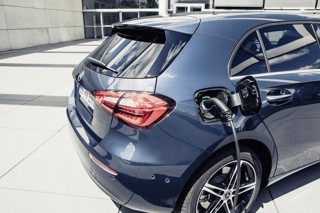The Government has launched a consultation on introducing green number plates for zero emission cars.
The aim is to raise awareness of the increasing number of zero emission vehicles on UK roads, help their drivers to benefit more easily from local incentives like free or cheaper parking and encourage greater uptake of new vehicle technology.
The special plates are already used by countries like Norway, Canada, and China.
Transport secretary Grant Shapps said: “The UK is in the driving seat of global efforts to tackle vehicle emissions and climate change and improve air quality, but we want to accelerate our progress.
“Green number plates are a really positive and exciting way to help everyone recognise the increasing number of electric vehicles on our roads.
“By increasing awareness of these vehicles and the benefits they bring to their drivers and our environment, we will turbo-charge the zero emission revolution.”
The Government first suggested it would look at adopting green number plates for the cleanest cars last year.
The move, according to the Department for Transport (DfT), marks another milestone for the Government’s Road to Zero Strategy, a £1.5 billion package of support which aims to make the UK the best place in the world to own an electric vehicle.
Since the strategy’s publication, the UK has seen record numbers of zero emission vehicles (EVs) registered and the Government has marked its intention to be the first G7 country to legislate for net zero emissions by 2050.
New company car tax rates have also been launched, with a new zero benefit-in-kind (BIK) tax percentage rate for pure electric cars.
Leasing companies have reported a surge in EV orders following the publication of the new company car tax rates in July.
Meanwhile, Lex Autolease announced this week that it has discounted 1,000 new electric vehicles through its EV1000 cashback initiative, with more than three quarters (83%) going to fleets.
The £1 million scheme has offered £1,000 cashback against each pure electric vehicle order since January.
Through the introduction of green number plates, the DfT says that local authorities would have a useful visual identifier should they wish to introduce incentives to promote the use of zero emission vehicles, such as allowing these drivers to use bus lanes and to pay less for parking.
A similar scheme was trialled in Ontario with drivers of EVs given free access to toll lanes and high occupancy vehicle lanes. Ontario saw an increase in EV registrations.
Elisabeth Costa, senior director at the Behavioural Insights Team, said: “The number of clean vehicles on our roads is increasing but we don’t notice as it’s difficult to tell clean vehicles apart from more polluting ones.
“Green number plates make these vehicles, and our decision to drive in a more environmentally-friendly way, more visible on roads. We think making the changing social norm noticeable will help encourage more of us to swap our cars for cleaner options.”
Potential plate designs include:
- A fully green number plate with black lettering.
- The addition of a green flash on the plate.
- The addition of a green dot or symbol.
Ian Johnston, chief executive officer at Engenie, said: “If we’re serious about transitioning to a low-carbon transport system, then incentives such as reduced parking fees for EV drivers, or allowing them to drive in bus lanes, is a no-brainier.
"These developments will help to boost driver confidence, alongside the rapidly expanding public charging infrastructure network that is now in place across the UK.”
Gary Smith, managing director of Europcar Mobility Group UK, added: “Green number plates for electric vehicles are an excellent innovative way to make it easier for local authorities to offer a range of advantages, from driving in bus lanes to additional parking. But we need more from Government in terms of financial incentives to purchase electric vehicles and grants to enable companies to transition to electric.”
The green number plate consultation seeks views from industry and the public on a number of aspects surrounding the scheme, including vehicle eligibility; number plate design; and the rollout of the plates.























Sooty the Sweep - 22/10/2019 11:56
Can I have brown or black plates on my Golf TDI, to signify its threat to the World??? Thought not.